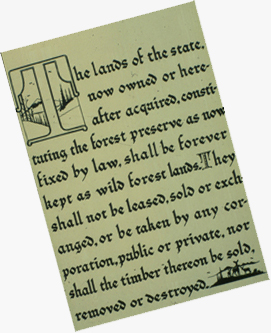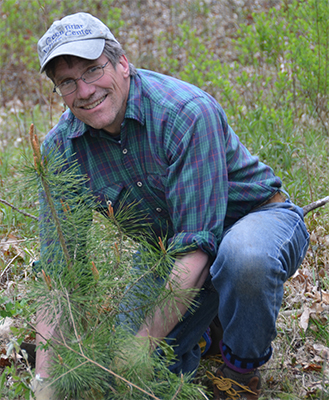
Mt. Van Hoevenberg and the Forest Preserve
By: Guest author - Dave Gibson, Adirondack Wild: Friends of the Forest Preserve
Original article ran in the Adirondack Almanack on August, 16, 2016

Article XIV - "Forever Wild Clause"
It can be an arcane field, the Forest Preserve. Article XIV, Section 1 of the State Constitution, the “forever wild” clause, is comprised of 54 words which appear clear enough. Its authors in 1894 thought it should slam the door on those late 19th century abuses of the preserve. The century-plus since has seen (mis)interpretations of law, purposeful evasions of law, statutes that contradict the NYS Constitution, contradictory opinions of attorneys general, contradictory rulings by our highest courts – the list goes on and on.
How to keep it all straight? For years, advocates have relied on the writings of Bob Glennon, Al Forsyth, Norman J. Van Valkenburgh, Neil Woodworth, and others to get to the heart of these inconsistencies, if you will.
Norm Van Valkenburgh, former Director of the Division of Lands and Forests with the NYS DEC, wrote in 1996:
“The reader might well wonder if after a century of constitutional protection of the Forest Preserve, it is really necessary that ‘eternal vigilance’ be exercised by those interested in the preservation of those State-owned lands in the Catskills and Adirondacks that are to be ‘forever kept as wild forest lands.’ Sadly, the answer is ‘yes’ and one need look no further than the site of the ‘bobsleigh run or slide’ at Mt. Van Hoevenberg in Essex County” (from The Forest and the Law).
An amendment to the Mt. Van Hoevenberg Unit Management Plan in North Elba comes before the Adirondack Park Agency this month, so I thought it timely to re-read Van Valkenburgh and recall his ceaseless vigilance as a Forest Preserve surveyor, historian, advocate and administrator.
Quoting The Forest and the Law:
“Anticipating the 1932 Winter Olympics and the need for a bobsled run, the Legislature passed and the Governor signed what became Chapter 417 of the Laws of 1929. It provided for the construction of a “bobsleigh run or slide…in the town of North Elba…” To the Department and to those constituency groups dedicated to the protection of the Forest Preserve, the whole thing was unconstitutional, and they agreed to make it a test case to set the parameters of just how much recreational development could be carried out in the Forest Preserve.
The case was carried through two courts, the Appellate Division and the Court of Appeals. The lower court, in an opinion written by Justice Harold J. Hinman, said, ‘if clearings of timber from lands owned by the State in the Forest Preserve are sanctioned for such a purpose (the bob-sleigh run) they are equally sanctioned for the construction of public automobile race tracks, toboggan slides, golf courses, baseball diamonds, tennis courts and airplane landing fields, all of which are out of harmony with forest lands in their wild state. There will be no limits to such encroachments that will crowd through the door of such precedent if established. As we view it, the Legislature has no power to open that door. If the people desire to use their great park for such recreation a constitutional amendment is necessary.”
“The Court of Appeals, in a March 19, 1930 opinion by Judge Frederick C. Crane, agreed and said, ‘tobogganing is not the only outdoor sport. Summer sports in the Adirondacks attract a larger number of people than the winter sports, simply for the reason, if no other that the summer time still remains the vacation period for most of us. The same plea made for the toboggan slide in winter might be made for the golf course in summer, or for other sports requiring the use or removal of timber. In other words, this plea on behalf of sport is a plea for an open door through which abuses as well as benefits may pass. The Constitution intends to take no more chances with abuses, and therefore says the door must be kept shut. The timber on the lands of the Adirondack Park in the Forest Preserve, or that on the western slope of the Sentinel range cannot be cut and removed to construct a toboggan slide simply and solely for the reason that Section 7, Article VII of the Constitution says that it cannot be done” (from VanValkenburgh, Land Acquisition for New York State).
These rulings about what does and does not cross the line in terms of recreational development on the Forest Preserve have long been known as “McDonald (then state commissioner of conservation, the defendant) v. Association for the Protection of the Adirondacks (the plaintiff),” or simply the “McDonald decision.” Article VII of the Constitution was renumbered Section 1, Article XIV as a result of the 1938 Constitutional Convention.
Foiled by these rulings, yet “eager to begin work in preparation for the 1932 Olympic Games,” the state legislature and governor acquired a 99-year easement on town-owned lands to construct the bob-sled run. By the 1960s, the easement over the bob-sled run, occupying 320 acres for the run, parking, etc. in North Elba, became permanent.
“At about the same time,” Van Valkenburgh wrote, “an adjoining parcel of 350 acres was acquired under the ‘Ski Centers and Special Uses’ category of the 1960 and 1962 bond acts. Under one interpretation of the decision rendered in the Hamilton County case (NYS Appellate Division 3d Dept. ruling of 1966), this 350 acres did not become a part of the Forest Preserve and, therefore, was not subject to the restrictions of the Constitution…
To further compound the complexity of the situation, lands adjoining these two parcels were already owned by the State and were considered by all as a part of the Forest Preserve. It was in this atmosphere and mix of land titles that plans began to be made for the 1980 Winter Olympic Games…
To be sure, the (1980) Olympics would be a boon to the North Country and the ‘watchdogs’ of the Forest Preserve became somewhat lax in their responsibilities of upholding the provisions of the Constitution. The parking area at the bottom of Mt. Van Hoevenberg and the bobsled run was expanded and paved. A portion of the expanded parking lot extended beyond the permanent easement lands and onto the adjoining Forest Preserve. A biathlon facility, including over three miles of trail and two bridges was constructed on the ‘ski centers and special uses land.’ These, of course, had a direct impact on the lands involved, whether Forest Preserve or not.
Of even greater impact, although indirect, was the transfer of administration of the Mt. Van Hoevenberg area and other winter recreation facilities, including the Whiteface Mountain Ski Center from the jurisdiction of the Department of Environmental Conservation to the Olympic Regional Development Authority. While it can be argued that the Authority is a State agency and the transfer was legitimate, the fact remains that the transfer document sounds mighty like a lease and calls into question the ignoring of that part of Section 1, Article XIV…that states the lands of the Forest Preserve ‘shall not be leased, sold or exchanged, or be taken by any corporation, public or private…’ However, even if the transfer was legitimate, the danger lies in the reality that the Olympic Regional Development Authority is anything but pro-Forest Preserve. One has only to look at the third word in its title to realize what the goal and purpose of the Authority really is.”
Forever wilders in the ‘60s strongly felt the decision in the Hamilton County case was unconstitutional, but it’s never been challenged. Article XIV states that “the lands of the state, now owned or hereafter acquired, constituting the forest preserve as now fixed by law, shall be forever kept as wild forest lands.” The court in the Hamilton County case held that “the State could acquire lands for any purpose within the forest preserve counties as long as the acquisition instrument (deed) specifically stated what that purpose was. In effect, the bob-sleigh runs decision said that the Legislature couldn’t amend the Constitution and the Hamilton County decision said that it could” (The Forest and the Law).
I will pause here to recall how, in 1991 or ‘92, I was invited, as a representative of the Association for the Protection of the Adirondacks, to walk the proposed paving of biathlon trails at Mt. Van Hoevenberg with then ORDA president Ned Harkness. A number of Forest Preserve advocates attended. It was quite impressive, the plans for expansion and paving for the athletes in Lake Placid. Harkness and DEC Commissioner Tom Jorling were eager for our support, but wary – as they ought to have been. This paving project required a lot of tree cutting just a short distance from the “McDonald decision” site. Our concern about the trail paving grew when Neil Woodworth of the Adirondack Mountain Club discovered that the parcel on which the paving was to occur lacked language in the deed stating that the acquisition was “other than for Forest Preserve purposes.” By the Hamilton County case standard, then, this was Forest Preserve. If the trees were cut, the trail paved and used for high speed sport it would constitute an abuse along the lines of those cited by the McDonald courts as plainly unconstitutional. Neil brought his evidence to a meeting with the DEC commissioner. If the cutting and paving commenced, we told Governor Mario Cuomo and the DEC, our organizations would take the state to court. Fortunately, the DEC could not evade the plain evidence that, even by its own standards, this was Forest Preserve.
Norm Van Valkenburgh picks up the story from there:
“As a result of the strong position taken by the ‘watchdogs’ of the Forest Preserve, the permits weren’t issued, tree cutting didn’t start, and the paving machinery didn’t run. However, the project – and others like it, one can be sure, lurks there just out of sight.
So ask the question again. Is eternal vigilance really necessary to assure the foreverness of the Forest Preserve? The answer is obvious.”
Governor George Pataki was the last Governor to try stretching the envelope in terms of recreational development at Mt. Van Hoevenberg. Some of us tried to dissuade him from going too far, with some success. In more recent years ORDA and DEC administrators have demonstrated greater restraint. The latest project to move Nordic skiing trails lost to private land development onto adjoining state lands seems reasonable and does not seem to cross a bright line. Mt. Van Hoe is a valuable, enjoyable recreational resource for the general public and for athletic training. Still, lacking a constitutional amendment here and keeping Norm’s advice in mind, the ‘watchdogs’ shouldn’t relax too much. Remember Judge Crane, 1930: “this plea on behalf of sport is a plea for an open door through which abuses as well as benefits may pass. The Constitution intends to take no more chances with abuses, and therefore says the door must be kept shut.”
For quotes in this post, I credit:
- The Forest and the Law II, an Inquiry into the Constitutional and Legislative Background of the New York State Forest Preserve and the Adirondack and Catskill Parks by Alfred S. Forsyth and Norman J. Van Valkenburgh, 1996 by the Association for the Protection of the Adirondacks;
- Land Acquisition for New York State, An Historical Perspective, by Norman J. Van Valkenburgh, 1985 by the Catskill Center for Conservation and Development.
|
|||

 David Gibson
David Gibson


